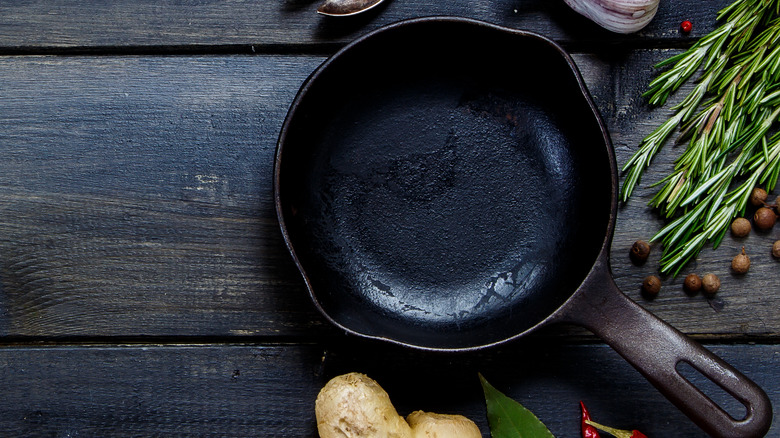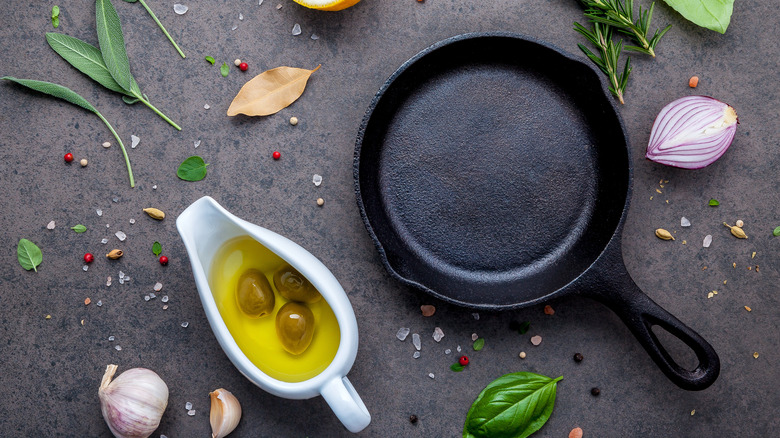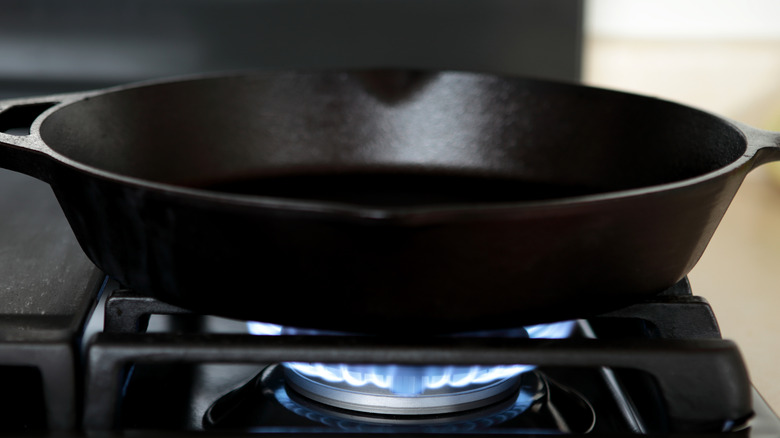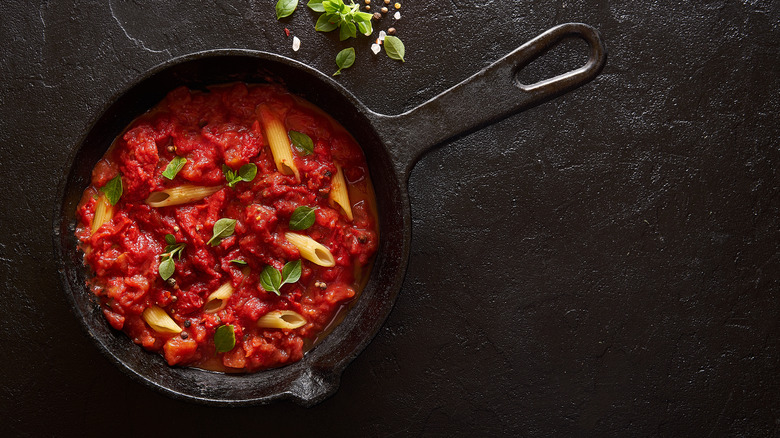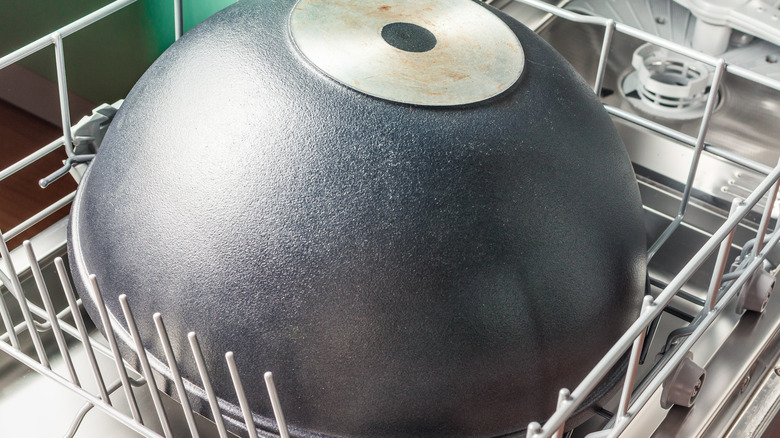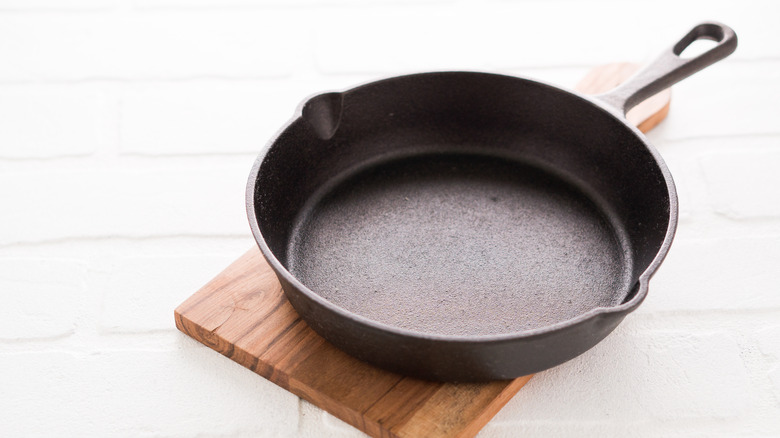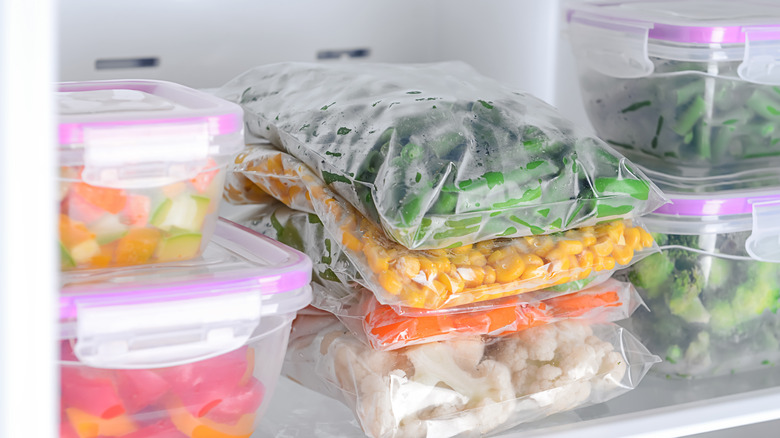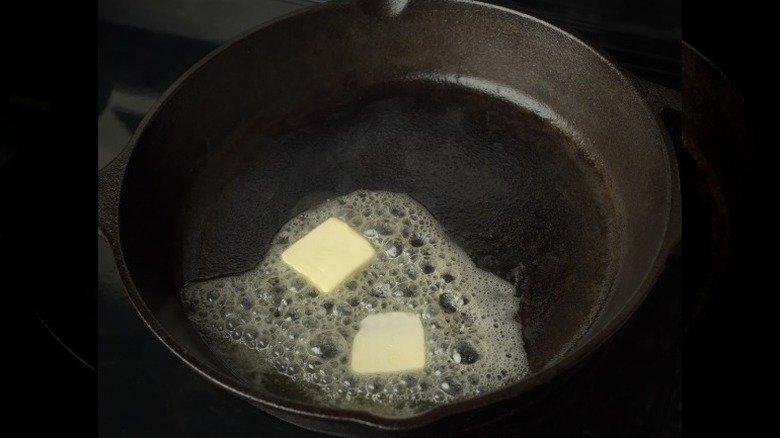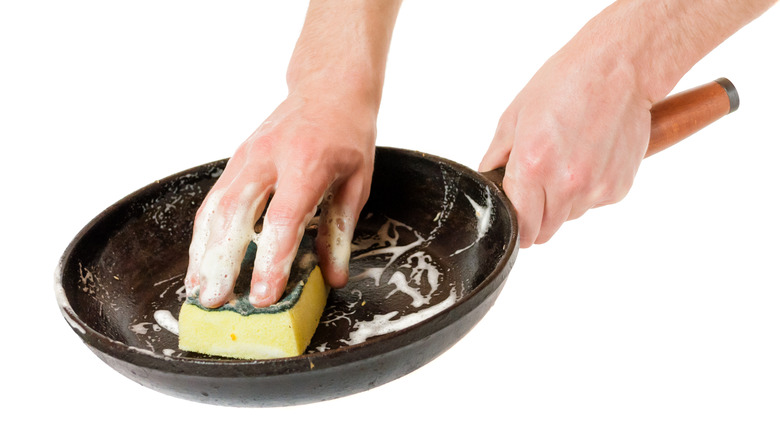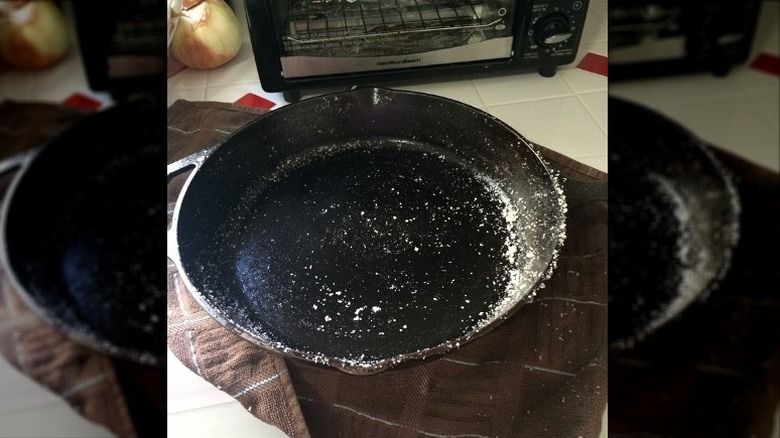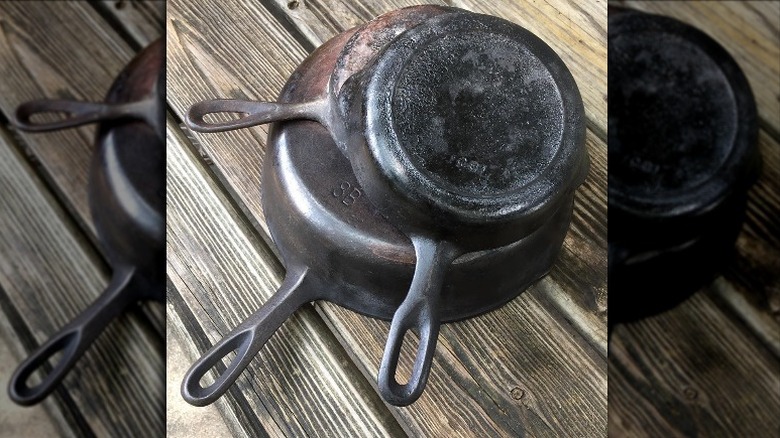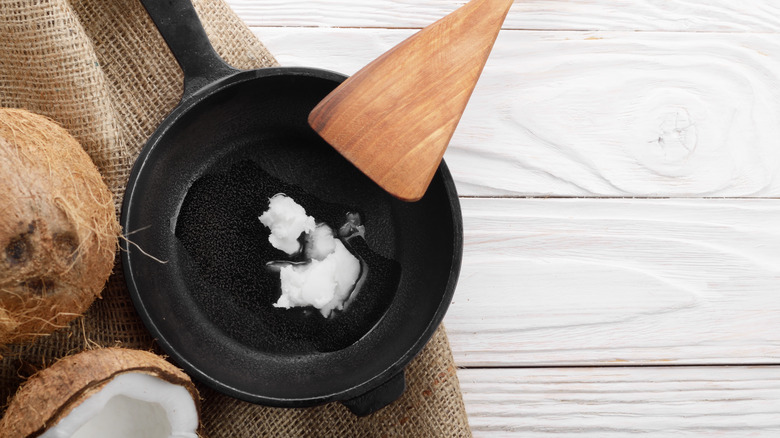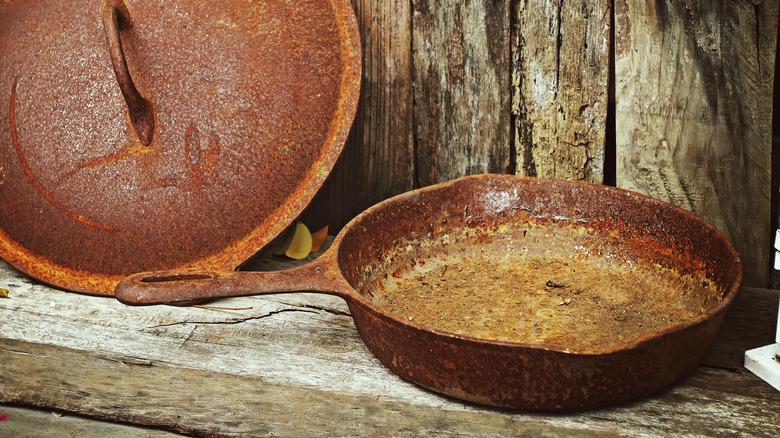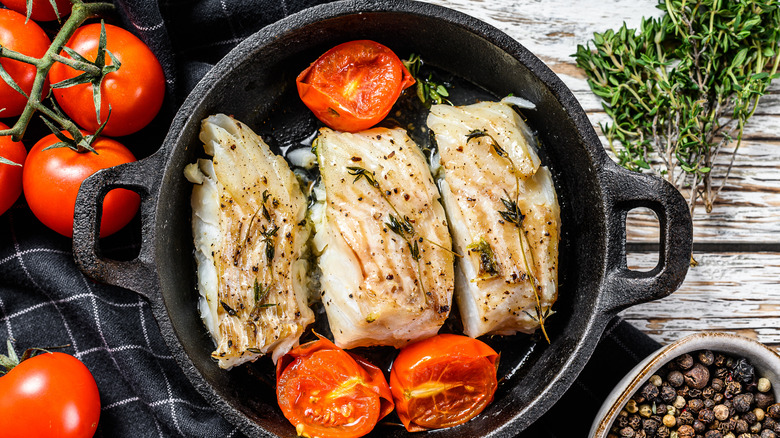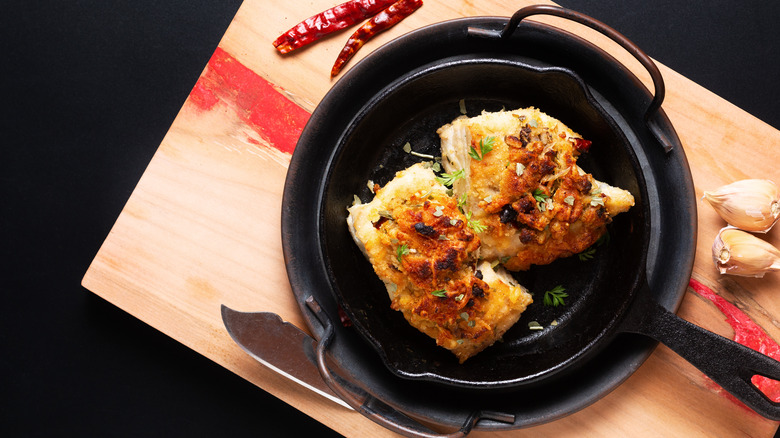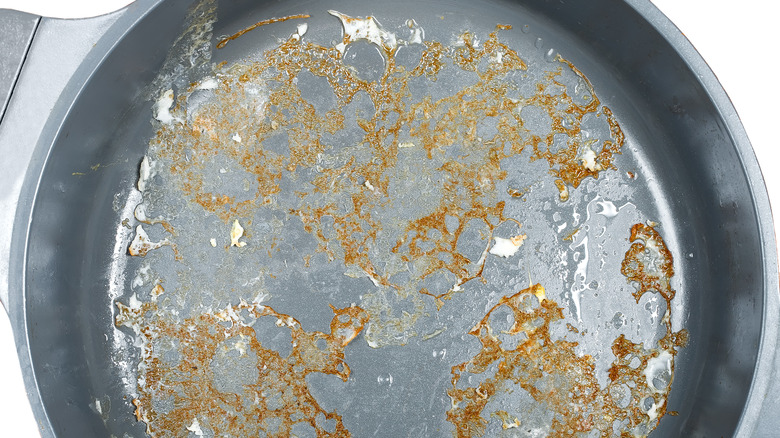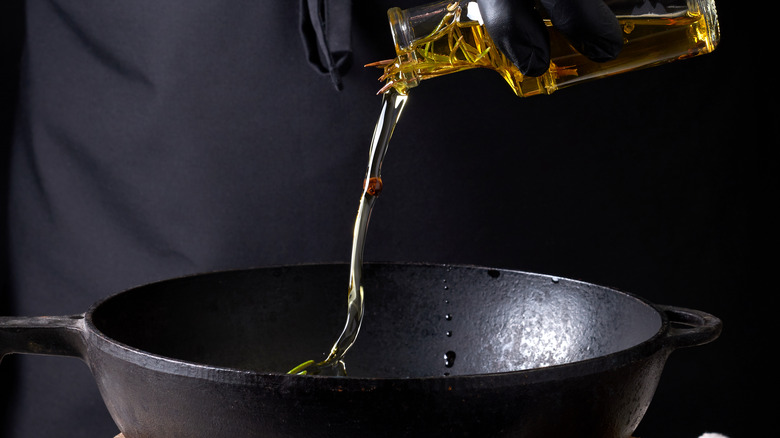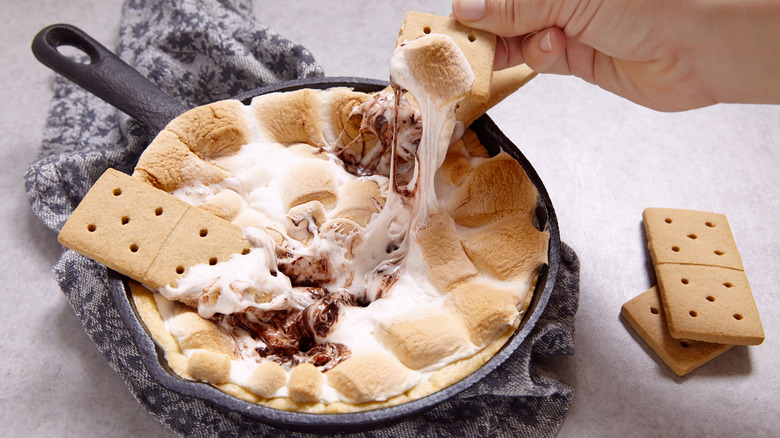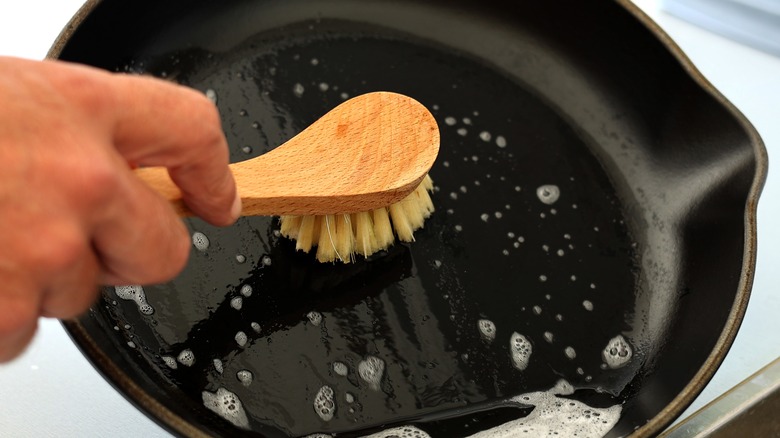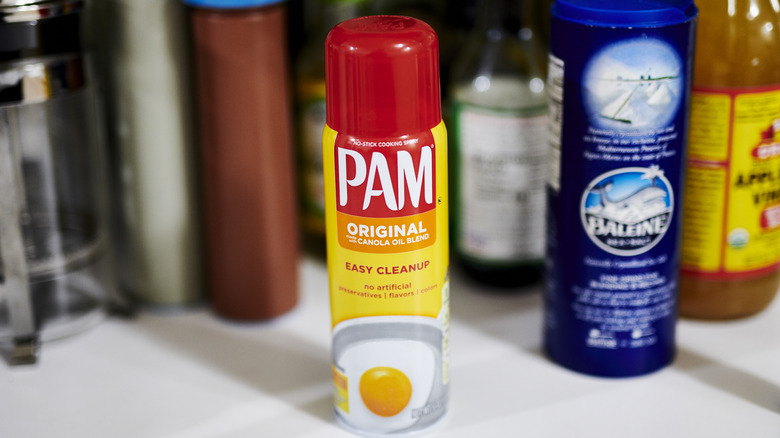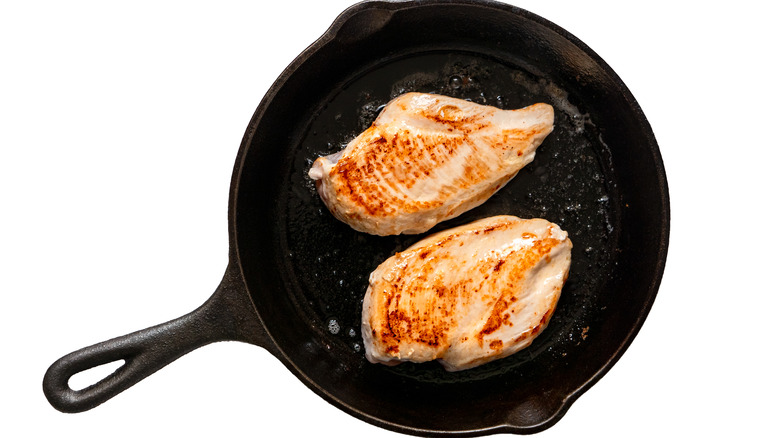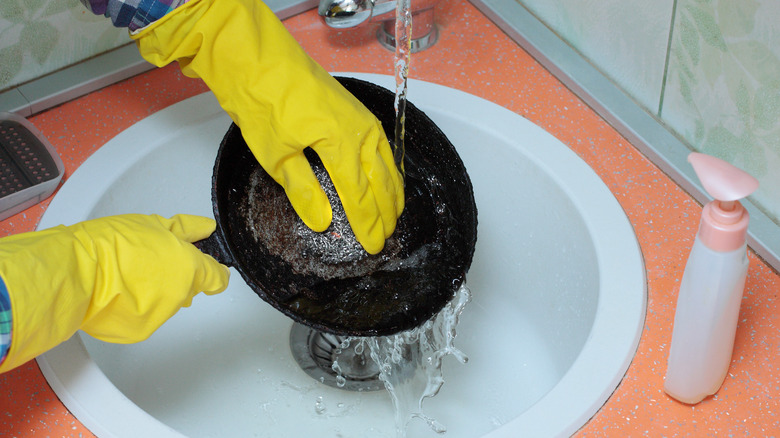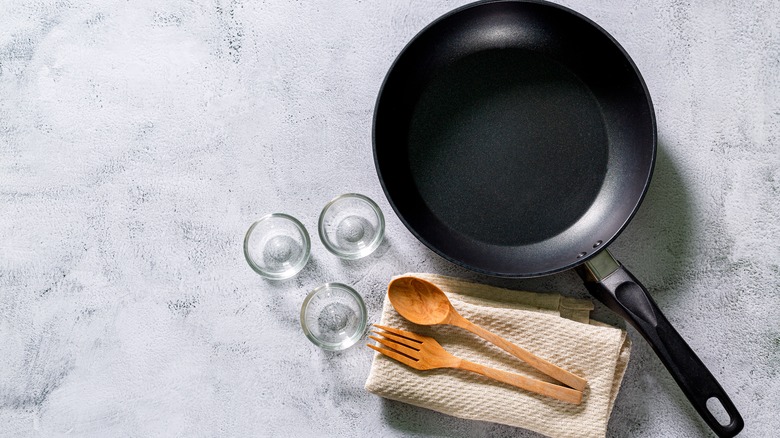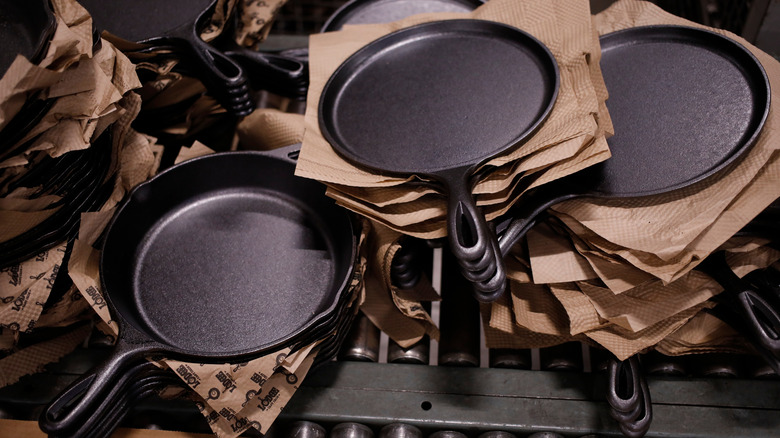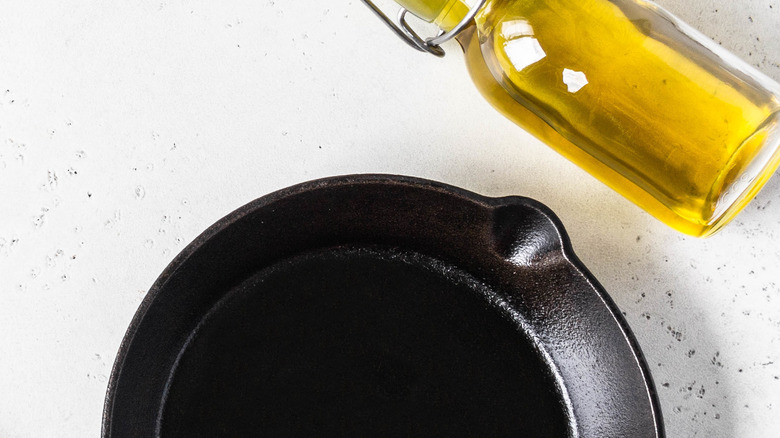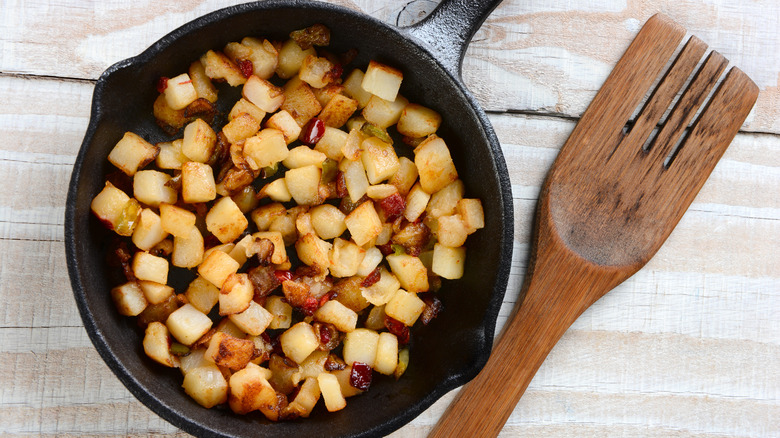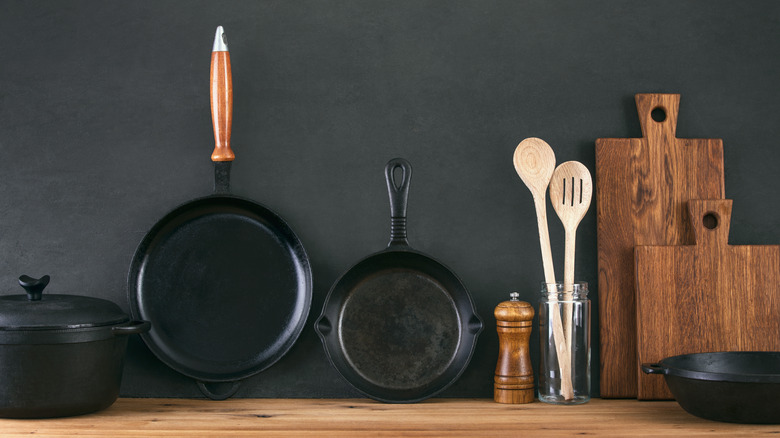26 Huge Mistakes You're Making With Your Cast Iron Skillet
Congratulations! You're the proud owner of a cast iron skillet. Maybe you were recently married and received one as a wedding gift. Or recently divorced and received one as a divorce gift. Or you're a college grad and you received one instead of a boring old fountain pen. Or someone purchased you one as a housewarming present. Or you came across one at your local thrift store. Regardless, you have a cast iron pan and you are ready to party — and by "party" we mean that you are ready to make like the Colonel and fry up some chicken. Not so fast! Slow down there, Iron Chef.
Your cast iron skillet may seem like a super tough, hardcore, durable kitchen workhorse, and it is, dear friend, it is. You can whip up all manner of delicious things in that cast iron skillet, and if you decide to live your life like a vintage cartoon it comes in awfully handy as a weapon. But there are also plenty of mistakes you can make with your trusty cast iron skillet, and before you go whipping up a paella you'll want to learn what those mistakes are so you know not to make them.
1. Mistake: You're not seasoning your cast iron skillet
As soon as you get a new cast iron pan, you may be tempted to turn on the gas and plop your skillet on the cooktop — but first you need to season it. The majority of cast iron skillets you purchase won't automatically have a nonstick coating, and that's where seasoning it comes in. Even if your pan is pre-seasoned, it's still a good idea to season it again.
So why exactly do you season your cast iron skillet? Because cast iron is porous. Field Company explains it like this: "If you put cast iron under a microscope, you'll see that its surface is bumpy and porous, and those bumps and pores expand once the pan is heated. Seasoning, especially in the early life of a pan, bakes right into the iron, filling in those pores and smoothing everything out into an even surface. Over time, as layer after layer of seasoning builds up, the cooking surface eventually becomes pure seasoning, securely bonded to the iron underneath." Seasoning your cast iron means that it will develop a nice slick patina so your food won't stick to the pan and you'll be able to flip those eggs with ease.
2. Mistake: You're seasoning your cast iron skillet in the oven
Most things you read will tell you it's best to season your cast iron skillet in the oven, adding a thin layer of oil to the pan before you set the oven on a high temperature and let your cast iron baby hang out in there for an hour. But that may not be the best way to go about things. Some cast iron aficionados think oven seasoning is ineffective and unnecessarily slow.
Issac Morton, founder of cookware company Smithey Ironware, told Gear Patrol, "In my opinion, when you're seasoning in the oven you're just protecting the skillet from rust and the elements. Other than cooking in it over and over again, what we call stovetop seasoning is the better method of seasoning." Morton goes on to say that by seasoning the skillet on the cooktop you are "able to apply a layer of seasoning on it that accelerates something like 10 years of seasoning process."
To season on the stovetop, just apply a light coating of oil, then wipe away the excess with a paper towel. Crank up the heat, and once it starts to smoke and look dry, apply another scant coating of oil. Do this for 10 to 15 minutes. This method will produce a lot of smoke, so make sure you have proper ventilation. But if it brings you quicker to getting that nice hard nonstick surface, it seems like the cooktop is the way to go.
3. Mistake: You're cooking all the things in your cast iron skillet
Nothing beats a delicious Bolognese sauce that simmers on the stove for hours while you add garlic and wine and tomato paste, but you should not cook food like this in your cast iron skillet until it's very well-seasoned. Dishes with high acidity like those containing tomato or citrus may take on a metallic taste if they are cooked in a cast iron skillet that isn't properly seasoned, and they can also strip off the seasoning you've worked so hard to cultivate. Bon Appétit even says deglazing with vinegar or wine can cause damage to the pan because of the acidity. Sure, adding some lemon zest to the chicken breasts you've been sautéing should be fine, but stewing tomatoes all day is a no-go.
Another tricky thing to cook in your cast iron skillet is fish. A lot of fish is too delicate for cast iron and will cook better in a non-stick pan. Even in a very well seasoned pan can, fish can be too difficult to flip or will fall apart too easily. One more reason to avoid fish is because cast iron can absorb the flavors of whatever is cooked in it. Unless you plan on having one pan for your savory dishes and pan for your sweets, you may not want to use your cast iron to cook fish and then bake up a Dutch Baby. No one wants a fishy pancake.
4. Mistake: You're putting your cast iron skillet in the dishwasher
It's easy to drink a bottle of wine (okay, two) with dinner and not feel up to dealing with cleaning your cast iron skillet. We've all been there, and before you crawl into bed after singing the entirety of Beauty and the Beat by The Go-Go's at top volume, don't you dare throw your cast iron skillet into the dishwasher. Letting your dog lick it is probably even a better cleaning method for it, because washing your cast iron skillet in the dishwasher is going to obliterate your seasoning and cause it to rust.
According to Hunker, "The combination of the scrubbing action, warm water and detergent effectively remove the seasoning in the pan." If you absolutely can't deal with cleaning your cast iron pan after using it, at least wipe out any food debris with a paper towel and leave it on your cooktop or counter to finish cleaning in the morning after you've chugged some Gatorade and taken some Tylenol. If you have a stuck-on food mess, you can add a little bit of water and try simmering it on the stovetop to remove it.
5. Mistake: You're not letting your cast iron skillet dry long enough
We know... Taking care of cast iron is a lot of work, but there's one more thing you have to be vigilant about: You can't put your skillet away with any moisture on it. Doing so is going to leave you with rust patches, and nobody wants that after working so hard at seasoning it.
After using your pan and wiping it clean, you want to make sure absolutely no moisture remains, and one of the easiest ways to do this is by putting your clean pan back on the cooktop. Faith Durand at The Kitchn says, "Place the skillet over a medium flame and let it sit until very dry — about 5 minutes. Let it cool, wipe out one more time, then put it away." Make sure the cabinet you store your cast iron skillet in is also dry and free of humidity, and place paper towels between each pan to prevent scratching and rusting. Another option is to hang your cast iron pans on a pot rack, where they'll not only be decorative, but the air flow will keep them from rusting.
6. Mistake: You're using your cast iron skillet to store leftovers
Your cast iron skillet is not Tupperware. You can't cover it with foil and shove your leftovers in the refrigerator in it. Not only will it mess with its seasoning and increase the potential for your cast iron skillet to rust, it may have other negative consequences as well.
Storing food in a cast iron pan may lead to iron toxicity. According to Hunker, "This is caused by ingesting too much iron. The iron is caused by the moisture that sticks to the food. When the food is ingested, so is the iron. In small quantities that's not a problem. However, for those people who have difficulty metabolizing iron, or hemochromatosis, that excess iron leads to fatigue, joint and stomach pain as well as other symptoms." Hemochromatosis, or iron overload disease, is said to affect as many as 1 million Americans, so it's better to be safe than sorry. Bust out those Ziploc baggies and your trusty Tupperware, and stick your leftovers in those instead.
7. Mistake: You're not preheating your cast iron skillet before using it
Before you start searing a steak in your cast iron, or cooking anything in it, you need to let it get hot. Not letting your cast iron skillet get hot before you start cooking in it causes your food to stick. Cast iron doesn't preheat evenly and it also takes a long time for it to get hot, but once it does it is excellent at retaining that heat.
You can preheat your skillet by placing it in your oven or by preheating it on the cooktop for about 10 minutes. Today advises, "Start the skillet over low heat, incrementally increasing that to whatever your desired cooking temperature is. Make sure you place the pan an inch or two off center and rotate it every couple of minutes, so it circles the heat source; this keeps the middle of the skillet from receiving all that direct heat and developing a hot spot." Another bonus to the stovetop preheating method is that by adding cooking fat while the pan is coming to temperature, you're helping to build up its seasoning.
8. Mistake: You're scared of using soap on your cast iron skillet
There are plenty of sources that will tell you to never use soap on your cast iron pan because soap will remove the seasoning. The reality is that a well-seasoned cast iron pan has been oiled and heated repeatedly, and the seasoning is actually a polymerized oil that has bonded to the surface of the metal. A little soap can't hurt that.
According to The Kitchn, "The oil combines with the porous surface of the pan when heated creating a surface harder and smoother than the pan itself. It would take a lot more than soap to remove the seasoning from a skillet." Field Company says that the whole myth about not using soap on your cast iron pans originated back when soaps were made with things like lye and other harsh compounds. Sure, you should never soak your cast iron skillet in soapy water for long periods of time, but if you have to use a little bit of soap to clean up some very gunked-on food it should be fine — just be sure to oil your cast iron after using soap as it can dry things out.
9. Mistake: You're not using salt to scrub your cast iron skillet
Instead of using soap to clean your cast iron pan, you might want to try other less invasive methods first, and one of the best ways to clean your skillet is by using good old kosher salt. Bon Appétit recommends pouring a cup of kosher salt into your still-warm pan and using a kitchen towel to scrub it. When you're done, simply rinse the pan with hot water and dry it very well before storing it. HuffPost suggests using both salt and a cut potato to scrub your pan. And WideOpenEats uses both salt and a nifty chainmail scrubber to remove stuck on food. In one Reddit thread, Alton Brown is quoted as saying he uses salt plus a little bit of fat to scrub his pan down, and if Alton Brown co-signs on something, you know it must be true. Regardless of which method you use, salt is cheap, readily available, and isn't too abrasive to use on your precious cast iron skillet.
10. Mistake: You're letting your cast iron skillet soak
Soaking cast iron is a big no-no. Sure, you'll find those brave souls out there who claim that they do it themselves or know someone who has soaked their cast iron skillet with no resulting problems, like this GardenWeb user who says, "My mother has always soaked her cast iron skillets. And washed them with soap and water, and even on occasion, scrubbed them with SOS. And they always seem to stay 'seasoned.' But hers are older than dirt and she has done years of frying in them..." According to the experts at Field Company, though, it's a risky move. "Soaking a pan with water overnight is a sure recipe for rust," they say, "but a brief rinse or few minutes' soak with warm water is fine."
Maybe that mama's cast iron was so well-seasoned after decades of frying chicken that she could get away with it, but it's still better to err on the side of caution and leave the long soaks to your other pans, or for you after you've prepared a complicated dinner and want a bubble bath.
11. Mistake: You're using the wrong cooking utensils on your cast iron skillet
It's hard to go wrong when it comes to the kitchen utensils you use on a cast iron skillet, and that's due to the fact that these pans are virtually indestructible. But some work better than others, depending on what you're cooking, and how well-seasoned your pan is.
A metal spatula is great for flipping delicate items and it may also help with the condition of your pan. According to MannKitchen, "I use a metal spatula in my cast iron skillet every day. My main skillet has never been stripped and re-seasoned, and the cooking surface has been IMPROVED by using a metal spatula on it. This is because the right spatula will lower the high spots in the natural texture of cast iron (left by the sand mold it was cast in), resulting in a smoother cooking surface that no longer makes that rusty nail-on-a-chalkboard sound when you scrape it."
Some suggest using gentler utensils on newly-seasoned cast iron. One Chowhound user advises, "I would either (a) use a very light hand with the metal utensils, or (b) use wood/bamboo/silicone utensils." It's a good idea to be gentle with your utensil choice until the seasoning has a chance to settle in.
For ease of use, reach for a silicone spatula. Elite Daily says that thanks to its flexible corners, you'll be able to navigate inside the pan no problem, plus it stands up to very high heat.
12. Mistake: You threw out your cast iron skillet because it got rusty
Don't throw away that rusted old cast iron skillet that was gifted to you by your great uncle (it's the thought that counts, right?) or that you stumbled across at a yard sale, because you can totally bring it back to life. Don't forget, cast iron is made to last forever. It's the stuff that heirlooms are made of, and if you take care of it chances are your baby's baby's babies will still be using it long after you're gone.
If you do have a rusted pan, you can save it with some steel wool and a lot of elbow grease. According to Taste of Home, you first want to scour it with the steel wool or a tough scrubber, a little water, and some soap. (Yes, you will remove the seasoning, but you will be adding more after all the rust is removed.) Once it's nice and clean, you want to rinse it, dry it very well, and start the reasoning process. Your cast iron skillet will be as good as new and you can get back to making all the pancakes you can eat in it.
13. Mistake: You're Cooking With Acidic Foods Like Tomato Sauce In Your Cast Iron Skillet
The cast iron skillet's explosion in popularity can be traced to the rediscovery of just how versatile a single kitchen tool can be. Most dishes and ingredients that are typically pan fried can be greatly enhanced using cast iron. But as tempting as it is, you shouldn't assume that your cast iron can handle just anything — namely, acidic foods such as tomatoes. Whether raw, as a paste, or in a sauce, tomatoes contain a high level of acidity that's not particularly good for your skillet.
According to HuffPost, the acidic reaction can even imbue your food with a metallic tang. While the amount of metal ingested is considered negligible, it's enough to make your spaghetti Bolognese taste a bit like an aluminum can. Not all hope is lost, however. While you should be wary of cooking acidic foods in a cast iron skillet, using a well-seasoned pan is less of an issue. You'll need that coating as the acid will quickly strip the seasoning right off the pan. If you do choose to cook tomatoes in your well-seasoned skillet, then get ready to start seasoning it all over again.
14. Mistake: You're Cooking Everything In Your Cast Iron, Including Seafood
A well-seasoned cast iron skillet makes a fantastic surface to cook on, but all of that baked-in seasoning can come with a cost. Namely, the oils ingrained in the nooks and crannies that make the pan such a perfect cooking surface will also absorb scents and even flavors of more pungent foods. This is the case with fish for instance. While Southern Kitchen recommends using a skillet to cook heartier fish like tuna or swordfish, remember to give it a full scrub down and re-seasoning afterward. That is unless you'd like your morning eggs or pancakes with a slightly fishy aftertaste.
While on the subject of fish, even top seasoned skillets don't make a good cooking surface for delicate fish. Popular fish like salmon risk sticking to a cast iron, which not only makes flipping it difficult but will also leave much of the fish stuck to the pan. This is because while cast iron skillets are good at retaining heat, they don't distribute it as evenly as other materials. Ultimately, this characteristic makes it more likely for delicate fish to stick to the pan.
15. Mistake: Not Scraping Off Food From Your Cast Iron
While most of your pots and pans can be left to soak in soapy water to remove residue, that's exactly what you should avoid with your cast iron skillet. Much like if you were to put it through the dishwasher, soaking cast iron is an easy way to develop rust. However, if you don't remove stray bits of food residue from the skillet, over time those scraps will gather moisture and become moldy directly on your pan. This is bad not only for your health, but your pan will also begin to develop an unappetizing smell.
The New York Times suggests an effective method for when you need to remove tough cooked-on remains from your cast iron skillet. All it requires is a scrub brush, a little water, and a small fistful of kosher salt. The coarse salt makes a potent cleaning agent as it can gently scrub off the residue while leaching away the grease. What's especially great about this method is that the salt dissolves easily, which means that although it pulls off the residue, your pan's seasoning will be left untouched.
16. Mistake: Letting Your Cast Iron Skillet Get Sticky
There's a prevailing idea among some cast iron skillet aficionados that having a greasy, sticky skillet means it's very well seasoned. This could not be farther from the actual truth, as a sticky skillet suggests the exact opposite. When the fats and oils have not properly ingrained themselves into the ridges of the pan, it doesn't take much heat for all of it to flake right off as you cook, leading your food to be in direct contact with the unseasoned metal.
If you have a sticky pan, the best course of action is to give it a thorough cleaning to remove any oils and fats. In order to season it properly, you want to start with a clean and unseasoned pan, as any caked-on oils or fats will take the existing seasoning with them as soon as they flake off. To remove the stickiness from your pan, Food & Wine suggests laying your skillet upside down on a sheet of aluminum foil and baking it for one hour at 400 F. This will dry out any sticky residue so that it easily flakes off, allowing you to season your pan properly.
17. Mistake: Cooking Both Sweet And Savory foods In The Same Pan
Remember what we said about cast iron skillets absorbing flavors and smells? Well if you'd like to test that theory, try making an especially fragrant fish dish followed by a baked cookie in the same pan with only a mild wipe down. Even if you flipped the order of dessert and dinner, rest assured that the latter will bear hints of the former.
A surefire way to make sure that your pan is deodorized and free of any lingering tastes is to bake it upside down in the oven to dry off any food particles or oils. Otherwise, vigorous scrubbing using dish oil and water also gets the job done. But in either case, it means you'll need to start seasoning your pan all over again. If you regularly like making sweet and savory recipes in a cast iron pan, Epicurious recommends purchasing a second skillet so that you can dedicate one for each type of recipe. That way you won't have to constantly clean and reseason over and over, and you won't have to worry much about cross contamination of flavors and scents.
18. Mistake: Not Cleaning Your Cast Iron Immediately After Use
Your cast iron pan does not have a Teflon coating, so leaving post-cooking residue to sit will only make it harder to scrub out the longer it stays on. One prevalent myth that often prevents cast iron skillet owners from cleaning their pans apart from a quick wipe-down, is the idea that anything more thorough will strip off all the precious seasoning. The truth of the matter is that if you're cleaning off your cast iron correctly, the seasoning will be retained.
According to Serious Eats, a simple application of dish soap and water with a sponge is all you need to regularly clean your skillet. If you're worried about losing any seasoning, don't be. Well-seasoned cast iron can withstand most ordinary cleanings. You would need to make a serious effort with rough tools and cleaners to remove the seasoning from your pan. So don't worry about accidentally scrubbing it off and be sure to regularly clean your cast iron.
19. Mistake: Using A Non-Stick Cooking Spray On Your Cast Iron
Using a non-stick cooking spray such as Pam on your cast iron skillet might sound like a shortcut to seasoning. And while these sprays can be used on most pan and skillet kitchenware, using them on cast iron will create way more problems than they solve. Southern Living explains that cooking sprays like Pam contain an ingredient called lecithin. While lecithin works fine with most other cooking surfaces, it can be detrimental to cast iron, as it will surely stick to a seasoned pan making it difficult to remove.
If you need more evidence, Frying Pro says that the use of a cooking spray on your cast iron will cause it to develop an unpleasant odor over time, since the spray adheres to the pan. Over time though, cooking sprays will contribute to the overall degradation of your cast iron skillet by creating a layer of permanent dust. So next time, be sure to reach for the butter or oil.
20. Mistake: Putting Ice Cold Food On A Piping Hot Skillet
One of the well-earned claims to fame cast iron skillets boast is the ease at which they form a crispy, flavor-sealing crust on most meats. This is what makes cast iron such an excellent surface for making something like fried chicken. However, this ability is predicated on both a hot pan and room-temperature meat that's ready to hit the toasty surface. According to Tasty, cold food hitting a hot cast iron is guaranteed to cause the food to immediately stick to the pan.
Letting your food reach at least an unfrozen temperature allows the cast iron to create a more slippery surface as it cooks the ingredients. If it's frozen or too cold, the pan will pretty much grip the food's exterior, negating its non-stick properties, increasing the likelihood of your food tearing and leaving scraps to clean, and ultimately robbing you of a delicious crust. The solution to this is fairly simple: Plan ahead. Have your food out and fully defrosted by the time you put your cast iron on the stove.
21. Mistake: Rinsing A Hot Cast Iron In Cold Water
While it's a good idea to start cleaning your cast iron as soon as you're done cooking, one of the worst things you can do is use cold water while your pan is still piping hot. Although food particles will wipe off more easily, unless you've given your pan a chance to cool down, you risk causing a sudden flare-up as the water hits any hot grease. While it won't cause a fire, the splattering oil can still burn your skin. Additionally, if the water is too cold when it hits the hot pan, you also risk causing thermal shock to the metal, per Eat This. Ultimately, this can lead to metal fatigue and cause the quality of the cast iron to degrade.
The best method to avoid both problems, according to CNet, is to first let your cast iron cool down to at most a warm temperature. This way you negate the risk of causing a grease splatter once you start cleaning. Then, be sure to let the water warm up before you use it to clean, in order to avoid thermal shock and potential damage to your pan.
22. Mistake: You're Not Reseasoning Your Cast Iron
Having black residue on your pan after cooking is a major red flag that demonstrates your pan has not been properly seasoned. Any oils and fats that should be forming the seasoned surface of the pan are instead burning and flaking off right into your food. This is bad in multiple ways, because not only does it make your food less appealing, but it also means your food won't properly cook on account of a lack of a nonstick surface on your pan.
World Of Pans recommends that the best way to cure blackened residue is by giving your pan a full scrub down and removing any substandard seasoning to prep it for a full reseasoning. Aim to remove enough oil and fat to reach the base layer of the pan, so that new seasoning can properly bond with the metal. Once the pan is fully dry, coat the cooking surface with a thin layer of oil, preferably applying it with a towel for optimal coverage. Once oiled, bake the pan at 450 F for one hour to allow the oil to break down and fully bond with the metal, creating a solid nonstick seasoned surface.
23. Mistake: Not Doing The Research When Purchasing A Cast Iron Skillet
There's more to buying a cast iron skillet than just hopping down to your local store and grabbing the first item on sale. The best cast irons are designed to last not just years but decades. If you don't do your due diligence then chances are you'll end up with a cheaply made cast iron model that will cause you more headaches — even if you paid full price.
According to the Michelin Guide (remember, this tire company is also in charge of selecting Michelin star restaurants), there are a number of ways to locate and purchase a high-quality cast iron that will ideally last you forever. Not all cast iron skillets are made the same way, however. Their design and production have also changed with the times. If you want to go with a classic old-school long-lasting skillet, consider eBay as a possible source.
Otherwise, know that most major skillet brands have a range of different qualities, and our selection of top skillet pans will set you up for success. The best advice is to look at how you want to use your cast iron and make your purchasing decision in line with these purposes.
24. You're assuming that all oils are created equal for seasoning your cast iron skillet
Now that you know how to season your cast iron, other than avoiding oven seasoning, another valuable thing to note is that some oils fare better than others, which leads us to flaxseed oil. What's so great about flaxseed oil? Not only does it have a neutral flavor that won't go pungent over time, it also has an exceptionally high smoke point which lessens the risk of kitchen hazards. In addition, while other oils may initially get the seasoning job done, they can also "soften" your cast iron skillet, thus leaving it vulnerable to scratches, and more pronounced wear and tear. Flaxseed oil, on the other hand, hardens the cast iron, making it both smooth but also better protected (via The Kitchn).
Given that nutritionists have been known to recommend that some oils –- including flax oil -– never be heated as heating can cause them to oxidize, Dr. Kara Fitzgerald explored whether or not it is indeed safe to season cast iron skillets with flaxseed oil. The conclusion drawn from this was, even though the oil cure can come off and get into food, there actually isn't any real way to completely avoid reactive oxygen species, and provided we're all taking care of ourselves, a little bit of exposure from your seasoned cast iron is not something to be concerned about. It's best to ensure you're using your cast iron skillet to cook with high-quality oils, and to load up on foods that are rich in antioxidants.
25. You're not cooking in your cast iron skillet enough
You've done all the research there is to do and made all the effort to carefully season your cast skillet. Quite possibly the worst mistake you can make now is just not using your cast iron skillet often enough! Sure, all that preparation may make you feel like it's a dainty ol' thing that should be brought out only for special occasions, but the single best thing you can do for your cast iron skillet is to use it often. This is because every time you cook in it, the oil and heat work as they did the first time you seasoned it. Hence over time, you are building layer upon layer of seasoning into your skillet; slowly rendering oil into it and leaving it with a smoother seal and tastier food.
If you're in need of some inspiration, you'll find that some of the best uses for your cast iron skillet include the following: baking deep dish pizzas, skillet cookies and cornbread, cooking one-pan dinners on open fires, roasting nutrient-dense vegetables, the possibilities are endless. Not only will your tastebuds smile, but your cast iron skillet will become the gift that keeps on giving. And what's more, because a small amount of iron gets absorbed into your food as you cook in the skillet (via MSU Extension), your body will be grateful for the mineral too.
26. You're not ensuring your cast iron skillet is completely moisture-free before and during storage
While a little bit of drip left on most crockery and cookware is usually a non-factor, cast iron thrives when it's moisture-free. Consistently storing your skillet with little drops of water will corrode the surface and create rust. As such, once you've cleaned your skillet, the best way to thoroughly dry it is, per MasterClass, by using paper or cotton dish towels, or microfiber cloth. If you want to be extra sure, you can even place them on low stovetop or oven heat for a few minutes. You can then store it by either stacking or hanging it.
Should you decide to stack, it's recommended that you place a paper towel sheet between your skillets to protect their surfaces, and you want to stack smaller skillets inside the bigger ones. Keep in mind that if you're storing Dutch ovens or cast iron skillets with an enamel coating, it's best not to stack them at all in order to avoid surface damage. You can also hang them, while this is probably more accessible, and can serve as a bit of an art display, according to Williams Sonoma, you must ensure that you're hanging them on sturdy racks and kitchen fixtures because cast iron is heavy. Ultimately, the most important thing here is that they remain dry, and far away enough that steam from other cooking or stray splashes of water from the sink does not land on your cast iron skillets.
